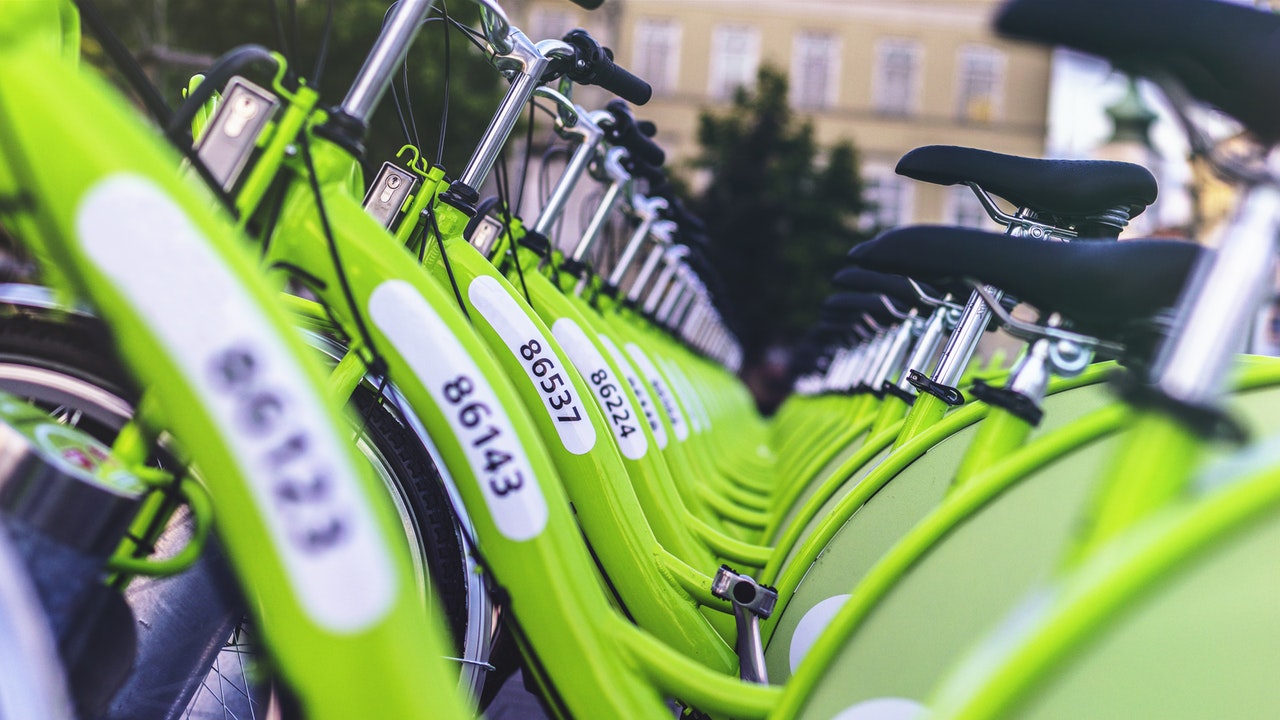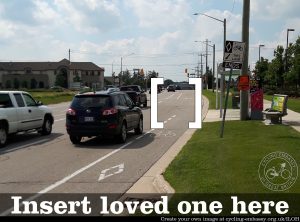Subscribe to get weekly updated delivered directly to your inbox!
Consultations, feedback, and events
- ION FIX-IT LIST: What details need correcting?
- WATERLOO: Draft zoning bylaw, comments due July 4
- KITCHENER: Urban Forest
- CAMBRIDGE: Transportation Master Plan
- TRANSIT:
- REGION:
- Victoria and Westmount, potential multi-use paths, comments due July 20
- Trade-offs in transportation
Vision Zero
In their monthly Kitchener Citizen columns, Councillor Gazzola, and to a lesser extent Councillor Fernandes, appear prepared to dismantle hard-fought city policies for sidewalk infill. Gazzola doesn’t believe there to be a safety issue on sidewalk-less streets, while Fernandes believes safety should be weighed against the “emotional impact” of residents receiving sidewalks. There are over 200 km of sidewalk infill remaining in the city’s backlog.
The Cycling Embassy of Great Britain has launched a new campaign, called “Insert Loved One Here,” to highlight instances of unsafe cycling infrastructure. You can create your own “Insert Loved One Here” photos using their website – be sure to share on Twitter with the hashtag #bikeWR.
A need for speed?
- 81% of Torontonians willing to trade lower speed limits for safer streets (The Star)
- No, lower speed limits don’t kill people. That’s crazy (The Star)
- Speed number one killer on Ontario roads as deaths rise (CBC)
Trails
The Grand River Conservation Authority is warning people to use caution on trails near the flooding Grand River. With the damage from the flooding, Kitchener has closed the Walter Bean Trail for repairs.
- Major improvements coming to the Iron Horse Trail this fall (570 News)
Protected cycling infrastructure
The Region has hired WSP Canada to perform planning and engineering for a Separated Cycling Network pilot project.
- Macon, Georgia, striped a good network of temporary bike lanes and cycling soared (Streetsblog)
Bike sharing
Are Kitchener and Waterloo getting two different bike sharing systems? A new Community Access Bikeshare website shows special mobile-phone activated locks for bikes located in Waterloo, while the CAB section of the Working Centre’s website still shows the lockbox system for Kitchener stations.
In Toronto, a new ‘dockless’ bikesharing service called Dropbike has launched around U of T. It sounds like they’re willing to work with other municipalities – maybe one (or more) of ours will bite?
- A stark comparison of parking vs bikesharing spaces (CityLab)
- Survey insights could help under representative residents reap the benefits of bike share (Portland State University)
Transit
Money for two-way, all-day GO service to Kitchener has been budgeted for the first time. A listing of Metrolinx capital projects shows a new $2.25 billion item for a “Kitchener Extension” – work that includes not only improving, doubling, and presumably electrifying track between Kitchener and Georgetown, but also the “Missing Link” freight bypass through Brampton. The work is currently in the design phase.
- Fare hikes for GO could be coming this fall (CBC)
- If Liberals can’t keep their meathooks off Metrolinx, they should disband it (TVO)
- Putting the “me” in transit: six tools to figure out what riders want (SPUR)
- Can we live without [ridership] prediction? (Human Transit)
Development and parking
- Integration of mobility and growth gets a boost (Urban Strategies)
- Yes-in-my-backyard: the new mantra of young urbanites pushing for denser development (The Star)
- So where are we on housing policy, anyway (TVO)
- Walkable urban areas can become playgrounds for the rich. Is there any way to prevent that (Vox)
- Dense urbanism is great for downtowns. But what about the suburbs? (Vox)
- American cities are chipping away at the burden of parking mandates (Streetsblog)
- On-street parking fees despite zero public transport? (Reinventing Parking)
Road ahead
- Agency gets $50k grant to offer more rides to seniors (CBC)
- Urban myth-busting: congestion, idling, and carbon emissions (City Observatory)
- Prices matter: parking and ride-hailing (City Observatory)



In many cases, removing “trees and landscaping that have been a part of their street for decades” *could* be avoided by narrowing the roadway (eliminating on-street parking), to make room for those sidewalks. Oh, wait, can’t do that. Sidewalks (and bike lanes) are not what destroys trees, it’s the priority of protecting parking and wide roadways.